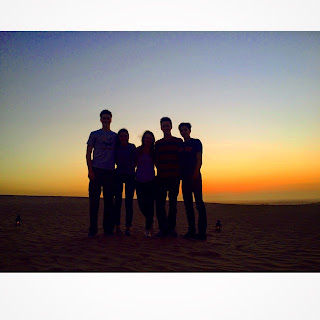These five took a trip to Paracas.
Lonny and I showed up although we told them to certainly not act like they knew us.
They took their own photos.
The resort was beautiful. Lonny and I lounged around the pool. The kids we recognized swam and did not properly apply sunscreen.
They did document the experience
and themselves.
There were mountains of sand
and a dune buggy
and posing
and some impressive air after sand boarding on those dunes
and a sunset dinner at the beach.
I know it sounds romantic:)
They were cute but sandy.
The view from our rooms was pretty great
at night
and all day.
This was my view of those five on the wave runners. We had planned on visiting the Ballestas Islands where you can see flamingos, penguins and sea lions but the waves were too intense for the boat ride there. This is the enticing description from the guidebook of the visit we missed: You're not allowed to walk on shore, but you wouldn't want to-the land is calf-deep in guano (bird droppings). Bring a hat, as tourist are moving targets for multitudes of guano-dropping seabirds. Also be prepared for the smell-between the sea lions and the birds the odor can drop you to your knees. I don't know why I feel bad the boat trip was canceled.
This was a bar. There are no age limits to be on the premises because those two little girls at the bar having a drink are like five.
These three were tired and sunburned and of course comfortable at the bar as well. I looked over later and saw one of them nursing a strawberry juice up at the counter and thought, Lonny and I are the best chaperones ever!
The town of Paracas is tiny and unremarkable but it has that beach.
They name their diners after girls but since we have a Jon and Jen in the family I thought we should check this place out.
This dog was pink. With spots. And hairless as are all the dogs in Peru. No beauty pageant winners here.
Paracas is close to Pisco and that means Pisco Sour. Peru's favorite brandy and national pride. If that's your thing then the opportunity to be photographed with some permanent drinking buddies was here and everywhere.
And there is always shopping although there wasn't always tourists in Paracas. Pisco was the destination of choice until a magnitude 8 earthquake in August of 2007 which they have yet to recover from.
Still we managed to acquire five matching Paracas shirts.
They never tire of striking a pose for their own camera
but just try getting a respectable
shot of five looking simultaneously with your camera.
Just be satisfied with one looking at a time.
These five are all the babies of their family with no siblings still living at home. It is just them and all that undiluted parent supervision. But at least they have each other.
And then we came home to the aloe vera lotion
and lived happily ever after.
The end.






























































